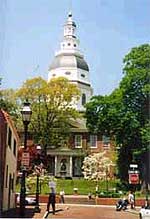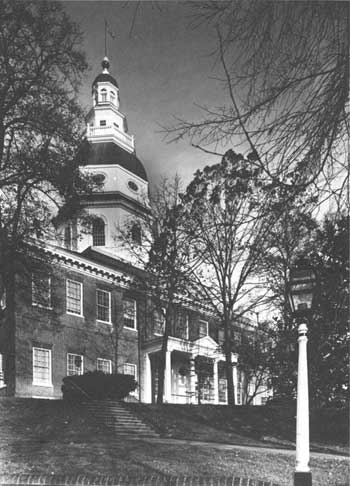







Survey of
Historic Sites and Buildings
 |
MARYLAND STATE HOUSE Maryland |
 Maryland State House |
| ||
This statehouse, whose soaring dome dominates the Annapolis skyline, is the oldest still in continuous use for legislative purposes and is one of the most historic buildings in the Nation. It has been the scene of many stirring events. Not only was it the Capitol of the United States in 1783-84, but it was also the meetingplace of the Annapolis Convention, the immediate forerunner of the U.S. Constitutional Convention, and since its construction has always served as Maryland's seat of government.
For 9 months, from November 26, 1783, until the following August 13, this structure was the U.S. Capitol under the Articles of Confederation, following the Continental Congress' relocation from Princeton, N.J. During its 6-month session, in what is known today as the Old Senate Chamber, the Congress on December 23, 1783, accepted George Washington's resignation as commander in chief of the Continental Army; on January 14, 1784, ratified the Treaty of Paris ending the War for Independence; and on May 7, 1784, approved the appointment of Thomas Jefferson as Minister Plenipotentiary. After adjournment on June 3, 1784, a "Committee of the States," which was charged with handling Government affairs, continued to use the chamber until August 13. In November Congress reconvened in Trenton, N.J.
 |
| Maryland State House. (National Park Service (Boucher, 1975).) |
But the building was destined to figure prominently once again in national affairs. Although Maryland did not appoint any delegates to the Annapolis Convention (September 1786), she made her capitol available for its sessions, which were probably held in the Old Senate Chamber. Because only 12 representatives from 5 States had arrived, no action was taken on the proposed topic, the recommendation to the States and the Continental Congress of measures to improve domestic and foreign trade. Instead, the conferees suggested that Congress and the States sanction another convention to consider means to strengthen the Articles of Confederation. This proposal was approved; the Constitutional Convention was the result.
In 1772 Maryland's last Royal Governor laid the cornerstone of the statehouse. Because of delays caused by the War for Independence, the structure was not completed until about 1779, and the next year the legislature began using it. The architect is unknown.
The two-story, late Georgian building, constructed of Flemish bonded brick in the form of a rectangle, is 11 bays wide and 7 deep. The dominant architectural feature, the 116-foot-high octagonal dome, replaced the considerably smaller original one and was apparently erected in the last half of the 1780's. Constructed of wood and held together by wooden pegs, it features a balustraded steeple and a two-story cupola and has arched, oval, and rectangular windows.
A three-bay central pavilion, which projects slightly, is topped by a triangular pediment with an oval window. Spanning the length of the pavilion is a one-story, Corinthian tetrastyle portico, whose small pediment is in the central bay. Built mainly of wood, the portico is probably a later addition. An elliptical arch, between the central pair of Corinthian wall pilasters, frames the paneled double door and fanlight of the main entrance, which is flanked by semicircular arched windows. All other windows, whose sills are stone, are rectangular. The flat and round arches over the openings are of rubbed brick. A belt course marks the second floor. Dentiled, wood cornices decorate the roofline, portico, and both pediments. Two large interior chimneys are located near the front wall on each side of the pavilion; a small chimney, on the rear, northeastern, side of the roof.
The arcaded main hall, under the dome and a second-story balcony, features Corinthian columns and delicate Adam-style plaster ornamentation. The room of main interest on the first floor is the Old Senate Chamber. It has been restored to its appearance on December 23, 1783, the day Washington relinquished his command. A bronze plaque marks the spot where he probably stood. Above the chamber entrance is a curved, balustraded spectators' gallery, which is supported by fluted Ionic columns.
The point of focus in the room is the semi-elliptical dais, or speaker's platform. Its rear niche is framed by a pedimented frontispiece, which has fluted, engaged Ionic columns. They are of wood, but the remainder of the niche and frontispiece are of plaster. The walls, above the wainscot, and the ceiling are plastered. Of particular note are a classically trimmed fireplace and the elaborate plastic cornice. Some of the decor in this chamber and elsewhere in the building is attributed to William Buckland. The windows have deep, paneled reveals, window seats, and inner shutters. Under the balcony, separated by a wood, paneled parapet, are two bilevel rows of seats for observers. The original yellow-pine floor is secured by pegs instead of nails. The chandelier is a reproduction.
Alongside the Old Senate Chamber is the Historical and Flag Room, which contains a special flag display and some exhibits. Opposite the Old Senate Chamber is the Old House of Delegates Chamber, which is primarily significant in Maryland history but is now occupied by the Attorney General's office. The offices of the Governor are on the second floor. Throughout the building are many excellent paintings and portraits.
The statehouse includes an annex, which is slightly larger than the original building. Constructed in 1902-5, it replaced two earlier ones (1858 and 1886) and contains the modern legislative chambers and various State offices. Guided tours of the building, which is in Colonial Annapolis Historic District, are provided.
 |
 |
http://www.cr.nps.gov/history/online_books/constitution/site10.htm
Last Updated: 29-Jul-2004